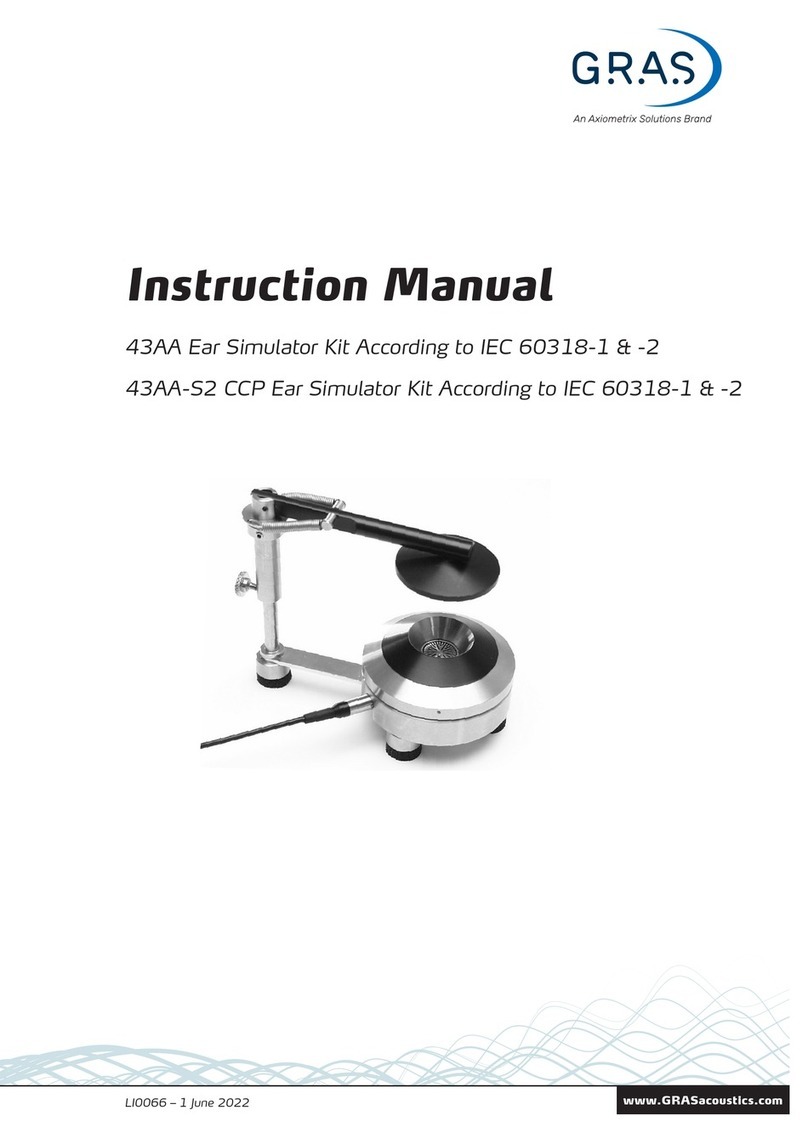GRAS 43AD User manual

Instruction Manual
43AD Ear Simulator Kit According to ITU-T Rec. P57 Type 1
43AD-S1 Ear Simulator Kit According to ITU-T Rec. P57 Type 1,
prepolarized
www.gras.dk
LI0069 – 1 June 2022

Revision History
Revision Date Description
1 17 August 2017 Extracted from Earbook as separate document
2 1 June 2022 TEDS compatibility section added
Copyright Notice
© 2005–22 GRAS Sound & Vibration A/S
http://www.GRASacoustics.com
Any technical documentation that is made available by GRAS is the copyrighted work of GRAS
and is owned by GRAS.
The content in this document is subject to change without notice. GRAS Sound & Vibration A/S is
not liable or responsible for any errors or inaccuracies that may appear in this document.
Trademarks
Any other product names mentioned in this document may be trademarks or registered trade-
marks of their respective companies and are hereby acknowledged.
2
LI0069 – 1 June 2022

Contents
Introduction.................................................................................. 4
TEDS Compatibility .................................................................................... 4
Components.............................................................................................. 4
Additional Equipment ................................................................................. 6
Test Procedure .............................................................................. 7
The 4 stages of the Test Procedure .............................................................. 7
1: Setting up the Ear Simulator ................................................................... 7
3: Placing the Ear Simulator over the Earpiece/Earphone ................................ 8
4: Applying the Test Signal and Analysing the Output from the Microphone ...... 9
Warranty, Service and Repair......................................................... 11
Calibration............................................................................................... 11
Warranty................................................................................................. 11
Service and Repairs.................................................................................. 11
Appendix
The RA0039 Ear Simulator IEC 60318-1 ....................................... 12
Introduction ............................................................................................. 12
Components............................................................................................ 12
Characteristics ......................................................................................... 13
3
LI0069 – 1 June 2022

Introduction
The 43AD Ear Simulator Kit is a complete assembly for acoustically testing telephone handsets
and earphones and complies with the following international requirements:
IEC 60318 Electroacoustics – Simulators of human head and ear - Part 1: Ear simulator for
the calibration of supra-aural earphones.
ITU-T Recommendations P.57 Series P: Telephone transmission quality, Objective measur-
ing apparatus: Artificial ears.
The 43AD is acoustically similar to the 43AA. The main difference is that 43AD is quicker to use
when testing is part of the production process (e.g. mobile phones). It can also be calibrated rapidly.
43AD Ear Simulator Kit is also available in a prepolarized version, the 43AD-S1.
TEDS Compatibility
The prepolarized version, 43AA-1 is IEEE 1451.4 TEDS v. 1.0 compliant. If your measurement
platform supports Transducer Electronic Data Sheets (TEDS), you will be able to read and write
data like properties and calibration data.
Components
43AD Ear Simulator Kit According to ITU-T Rec. P57 Type 1, ext. polarized
The 43AD comprises the following main components:
RA0039 IEC 60318-1 Ear Simulator, see page 12
40AG ½” Pressure Microphone
26AK ½” Preamplifier
AA0008 3m Extension Cable
GR0332 Snap Coupling (female)
GR0336 Snap Coupling (male)
43AD-S1 Ear Simulator Kit According to ITU-T Rec. P57 Type 1, prepolarized
The 43AD-S1 comprises the following main components:
RA0039 IEC 60318-1 Ear Simulator, see page 12
40AO ½” Pressure Microphone, prepolariced
26CA ½” CCP Preamplifier
AA0034 2 m BNC Cable
GR0332 Snap Coupling (female)
GR0336 Snap Coupling (male)
When assembled as shown in Fig. 1, it is ready for testing supra-aural 1 earphones such as telephone
handsets and headphones. Fig. 7 on page 10 shows an exploded view of its user-serviceable com-
ponents. The following mounting plate is also provided for testing circumaural2earphones:
GR0339 for testing circumaural earphones
It has to be mounted accordingly in place of the removable ring (GR0338) surrounding the
entrance to the Ear Simulator, see Fig. 2.
1 An earphone applied externally to the ear
4
LI0069 – 1 June 2022

2An earphone with a cavity large enough to cover the region of the head which includes the ear. The concentric circles on the
GR0039 (Fig. 2) are provided to help place the earphone correctly in relation to the entrance to the Ear Simulator.
GR0332
Snap Coupling
(female)
½" preamplifier
GR0336
Snap Coupling
(male)
RA0039
Ear Simulator
½" microphone
GR0338
removable ring
Fig. 1. Assembled 43AD/43AD-S1 Ear Simulator Kit
Fig. 2. 43AD shown with mounting plate GR0339 for testing earphones fitted with fluid cushions (circum-aural)
Ground Loops
In certain test set-ups, particularly if they are automated, there can be a risk of ground loops
passing through the artificial ear and resulting in extraneous noise in the test results. If this is a
likely problem, please contact G.R.A.S. before ordering. The solution will be to use the prepolar-
ized version with protective grid and male snap coupling made of plastic.
5
LI0069 – 1 June 2022
Table of contents
Other GRAS Industrial Equipment manuals



















